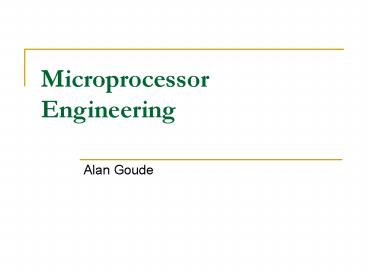Microprocessor Engineering - PowerPoint PPT Presentation
1 / 21
Title:
Microprocessor Engineering
Description:
Microprocessor Engineering. Microprocessor Systems. Microcontrollers. ARM7 ... real-time (hard ... Gate Array. Microcontroller-based System-on-a-Chip ... – PowerPoint PPT presentation
Number of Views:252
Avg rating:3.0/5.0
Title: Microprocessor Engineering
1
Microprocessor Engineering
- Alan Goude
2
Microprocessor Engineering
- Microprocessor Systems
- Microcontrollers
- ARM7 core Processor Family
- specifically NXP LPC2368 microcontroller
- C Programming will be used throughout
- ARM Realview MDK - 'C' compiler other tools
- u-Vision Integrated Development Environment
3
Microprocessor system
- CPU
- Memory ROM and RAM
- Input various
- Output - various
4
Bus system
- Devices connect to microprocessor via bus system
(often called the memory bus) - A devices connected to bus must be tri-state
devices - only one device is activated at a time
- Consists of 3 bus types
- Address bus
- Data bus
- Control bus
5
Bus operations
- Read
- Write
- Each read/write operation is made up of a number
of clock cycles or T states - Each machine instruction is made up of one or
more read and/or write operations - This is why we shouldn't compare microprocessors
simply based on clock speed
6
Address Bus
- unidirectional generated by microprocessor
- number of address lines determines number of
address locations - addressable locations 2n where n is the number
of address lines - Memory map shows the position of devices within
the whole of the addressable area
7
Data Bus
- Bi-directional
- Usually matches the word length of the
microprocessor - Usually a multiple of 8
- We talk of 8-bit, 16-bit , 32-bit and 64-bit
processors which refers to the normal word length
of the microprocessor
8
Control bus
- Consists of potentially many signals. Typically-
- Read
- Write
- Could be single signal - Read/notWrite line
- Interrupt control
- Bus control signals for DMA (Direct Memory
Access)
9
Microprocessr
- CPU Central Processing Unit
- ALU Arithmetic Control Unit
- Registers
- Control Unit ( usually microcoded)
10
Microprocessor Registers
- General purpose register file
- Status or Flag Register indicate result of last
instruction executed - Program Counter (PC)
- Stack pointer
- Special registers Internal to CPU and generally
not available to the programmer. - On reset and power up PC is loaded with a
particular value, typically zero.
11
The Fetch Execute cycle
- Fetch
- memory read cycle
- place in instruction register and decode
- Execute
- may involve additional read and/or write cycles
- Often the whole Fetch-Execute cycle is carried
out through a pipeline operation involving
several stages. - 5 stages are often used (IF, ID, RR, EX, WB)
- The Pentium 4 has 20 stages
- The ARM 7 has 3 stages
12
Microcontroller
- A microcontroller is the integration of
- microprocessor
- memory
- ROM types commonly flash PROM
- RAM Static ram
- peripherals
- parallel input and output(digital I/O)
- Timers and Counters
- Serial input and output (UART, USART, SPI etc.)
- Analogue to digital converters
- PWM, CAPCOM registers, DACs etc.etc.
13
What is an Embedded Computer System
- Special purpose computer usually with one
specific task or application. - Usually embedded in a device which often has
other electronic and mechanical parts - Usually optimised for the specific task
- Has the usual basic computer components CPU,
memory, inputs outputs
14
Examples
- consumer appliances
- tv's, mp3 players, dvd's, washing machines etc.
- automotive applications
- engine management, anti-lock braking
- computer peripherals
- hard disk controllers, routers, switches
- medical equipment
- scanners, blood analysers
- telecoms
- mobile phones
- aerospace
- satellite control systems, avionics
15
Some Characteristics
- Very simple to very complex applications
- Often single application
- but concurrent operation
- Could be real-time (hard and soft)
- Program is normally stored in ROM called
firmware flash ROM commonly - Could be critical applications
- Interfacing with other devices via peripherals
- Require a range of development tools hardware
and software - May use operating system (RTOS)
16
Constraints
- Physical size
- Weight
- Power usage
- Performance throughput and/or response time
- Cost
17
Resulting in -
- limited space
- limited processing power
- 8-bit processor
- limited memory RAM ROM
- only Ks of memory not Ms
- schemes to limit power consumption
- low power modes
- sleep
- standby
- determinism needed for RT guarantee
18
Linksys Wired Wireless Router
19
Linksys WRT54GL Router Access point
- CPU Broadcom BCM4712KPB _at_ 200 MHz
- RAM 16MiBytes (2 x S42S16400 RAM Chips)
- ROM 4MiBytes (Intel TE28F320 C3 Flash ROM)
- I/O
- WAN port One 10/100 RJ-45 port
- LAN port Four 10/100 RJ-45 ports
- Wi-Fi Channels 13
- LED Indicators power, DMZ, WLAN, port 1/2/3/4,
Internet
20
Microprocessor vs Microcontroller vs Soc vs FPGA
- uP
- General purpose
- external memory and peripherals
- connected by a memory bus
- uC
- uP integrated with memory and peripheral
interfaces - families of uC all with same uP but varying
amounts and types of memory and interfaces.
21
Microprocessor vs Microcontroller vs SoC vs FPGA
- SoC System on a chip
- FPGA Field Programmable Gate Array
Microcontroller-based System-on-a-Chip

